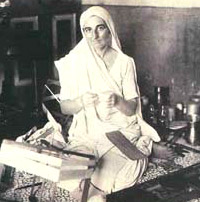Madeleine Slade (Mirabehn) (22 November 1892 – 20 July 1982), daughter of the British Rear-Admiral Sir Edmond Slade, was a British woman who left her home in Britain to live and work with Mohandas Gandhi, the leader of the Indian independence movement. She devoted her life to human development, the advancement of Gandhi’s principles and the freedom struggle in India. In doing so, Gandhi gave her the name Mirabehn, after Meera Bai, the great devotee of Lord Krishna.
Mirabehn was born into an aristocratic British family in 1892. Her father, Sir Edmond Slade was an officer in the Royal Navy who was posted in her early years as the Commander-in-Chief of the East Indies Squadron, later becoming director of the Naval Intelligence Division.She spent much of her childhood with her maternal grandfather who owned a large country estate and was from an early age a nature and animal lover.
The other great passion of the young Mirabehn was the music of Ludwig van Beethoven. She took to the piano and concerts and even went on to become a concert manager. In 1921 she even arranged for a German conductor to lead the London Symphony Orchestra in concerts featuring Beethoven and helped bring about an end to the British boycott of German musicians that followed the First World War.
She also visited Vienna and Germany to see the places where Beethoven had lived and composed his music and she read extensively on him. She read Romain Rolland’s books on Beethoven and later sought and met with him at Villeneuve, where he was then living. During this meeting, Rolland mentioned about a new book of his called Mahatma Gandhi which she had not read then. Rolland described Gandhi as another Christ and as the greatest figure of the 20th century.On her return to England she read Rolland’s biography of Gandhi and the book convinced her to become a disciple of the Mahatma. She wrote to Gandhi asking him if she could become his disciple and live with him in Sabarmati Ashram. Gandhi replied, inviting her over but also warning her of the ascetic discipline of the Ashram’s inmates.Having made her decision, she went about training herself for all the demands of an ascetic’s life in India including vegetarianism, spinning and teetotalism. That year in England, she subscribed to Young India and spent a part of her time in Paris reading the Bhagvad Gita and some of the Rigveda in French.
After her release from the Aga Khan Palace, with Gandhiji’s permission, she established the Kisan Ashram at a site near Roorkee. The land was donated to her by the local villagers. After Independence, she established the Pashulok Ashram near Rishikesh and a settlement named Bapu Gram and the Gopal Ashram in Bhilangana in 1952.She took to dairying and farming experiments in these ashrams and also spent a while in Kashmir. During the time she spent in Kumaon and Garhwal she observed the destruction of the forests there and the impact it was having on floods in the plains. She wrote about it in an essay titled Something Wrong in the Himalaya but her advice was ignored by the Forest Department. In the 1980s, these areas witnessed a large Gandhian environmental campaign to save the forests called the Chipko Movement.
She returned to England in 1959. In 1960, she relocated to Austria and spent twenty-two years in Vienna, where she died in 1982.
She was awarded India’s second highest civilian honour, the Padma Vibhushan in 1981.
(Ref:https://en.wikipedia.org/wiki/Mirabehn & Free Keyword suggestion tool)
